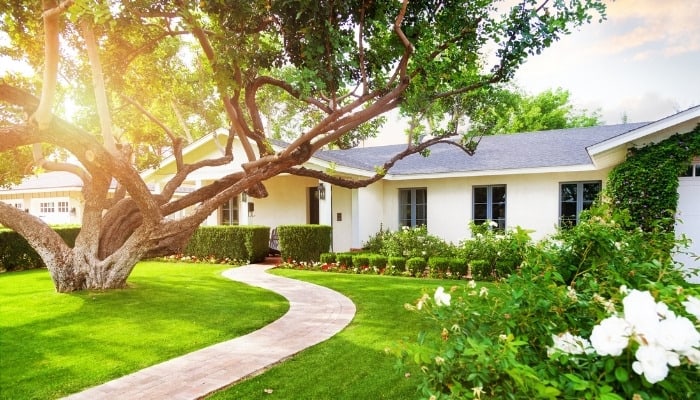Unable to process the request due to encountered difficulties.
The presence of leafy trees provides shade, seclusion, and defense against strong winds. However, in Arizona, one must carefully consider factors like drought and the potential invasiveness of selected trees.
Finding the perfect match for your yard can be tricky. Ideally, the best shade trees for Arizona are native, tall, low maintenance, and long lived.
Let’s take a look at the options!
1. Palo Verde
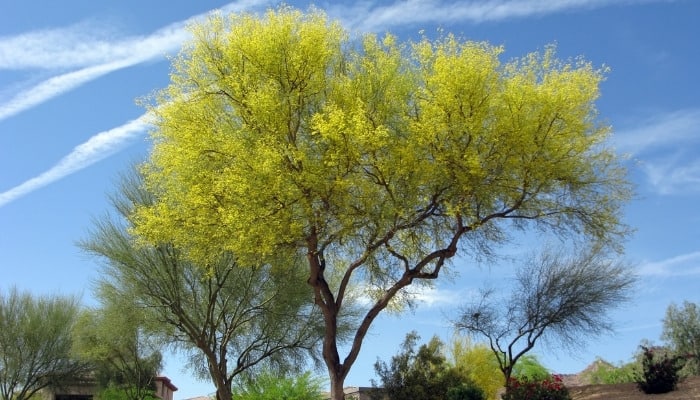
- Botanical name: Parkinsonia microphylla
- Average size: 20 feet
- Growth rate: Slow
- Drought tolerance: High
Although there are multiple varieties available, the Foothill is the one native to Arizona. Yet, all the varieties have a vibrantly-colored green bark capable of performing photosynthesis.
Hence, the Spanish name Palo Verde that translates to “Green Stick.”
Once spring rolls in, you’ll see the yellow blossoms. For a stronger color pop, use the shade created by the tree to raise lantana flowers or colorful cactus.
Some people might be allergic to Foothill trees. Additionally, they get can be messy as they shed during the fall.
2. Southern Live Oak
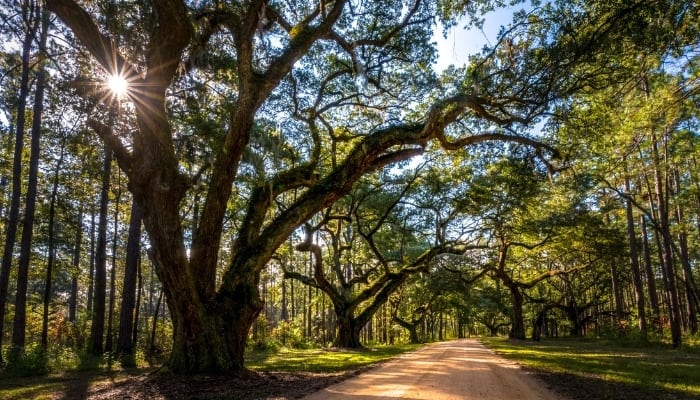
- Botanical name: Quercus virginiana
- Average size: 50-60 feet
- Growth rate: Slow
- Drought tolerance: High
The Southern live oak maintains its green leaves all year round. This evergreen tree is mostly low maintenance.
Yet, annual pruning during the first three years is crucial to shaping the trunk appropriately since they’re usually aggressive spreaders.
However, these oaks are only a good match if you have a lot of open space. They usually need at least 15 feet of free distance.
Another downside is the potential Spanish moss takeover. It’s not harmful to the tree itself but does detract from the beauty of the tree.
3. Cat-Claw Acacia
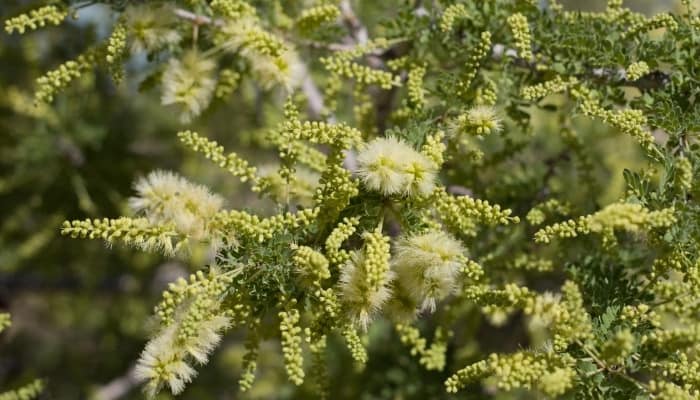
- Botanical name: Senegalia greggii
- Average size: 15 feet
- Growth rate: Moderate
- Drought tolerance: High
With only a single watering every month, the deciduous cat-claw acacia tree can survive Arizona’s harsh climate.
In case you’re wondering about the odd name, it comes from the weirdly-shaped thorns, and yes, it’s as sharp as it sounds. So, be careful!
The cat-claw is multi-trunked by nature, but most domesticated trees are pruned to a single trunk.
Other species that grow in Arizona are Whitethorn and Willow Acacias. The latter prefers the heat of the South, though.
4. Chinese Pistache
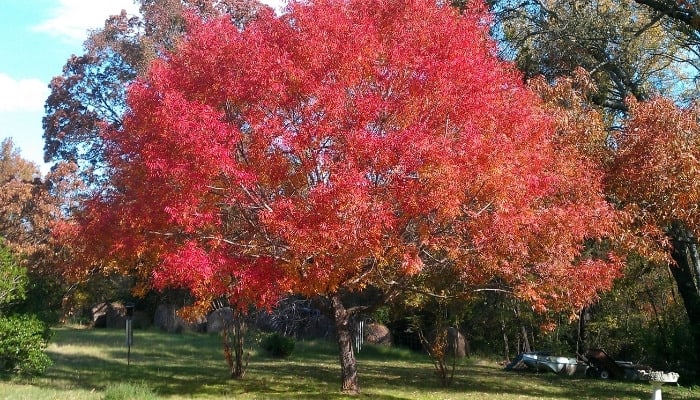
- Botanical name: Pistacia chinensis
- Average size: 35 feet
- Growth rate: Slow
- Drought tolerance: Very high
The Chinese pistache foliage changes colors from green to a vivid orange-red during the fall.
They’re thornless, non-invasive, mostly non-allergy triggering, and drought tolerant, making them ideal for yards around USDA Zones 6-9 under the blazing Arizona sun.
However, transplanting can often be stressful to the tree.
To reduce the chances of wilting during transplanting, we recommend doing it during the spring or fall.
5. Desert Willow
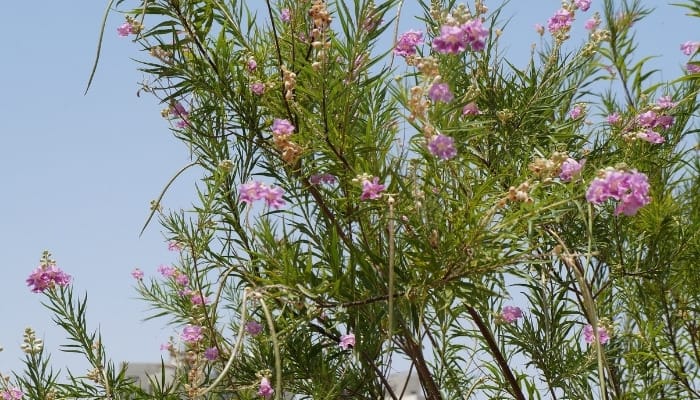
- Botanical name: Chilopsis linearis
- Average size: 20 feet
- Growth rate: Fast
- Drought tolerance: Very high
The desert willows provide excellent shade for the summer but still lose their foliage for the winter, allowing the sun to warm up your yard.
If you don’t like the look of bare trees, pair it with winter flowers like pansies. This way, you get the best of both worlds!
Freshly transplanted trees need weekly watering. After a month or so, once every 4-6 weeks is enough.
Some people have the mature trees benefit from natural rainwater irrigation with minimal human intervention, and this often works well.
6. Chinese Elm
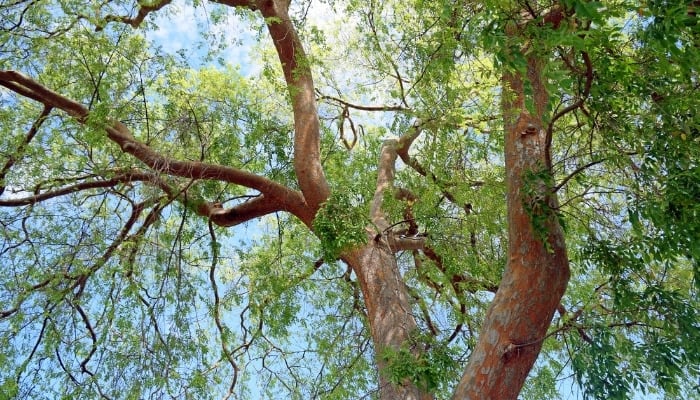
- Botanical name: Ulmus parvifolia
- Average size: 35 feet
- Growth rate: Fast
- Drought tolerance: Moderate
The Chinese elm may not be as drought tolerant as other plants on the list. You might need to water 2-3 times every week.
You also need to be mindful about the area around its base since elms can easily crack sidewalks as their roots spread.
Ideally, the entire shaded area should be left natural with no sidewalks or driveways nearby.
Instead, use the shade as an opportunity to grow flowering shade-tolerant plants like daffodils.
7. Coral Gum
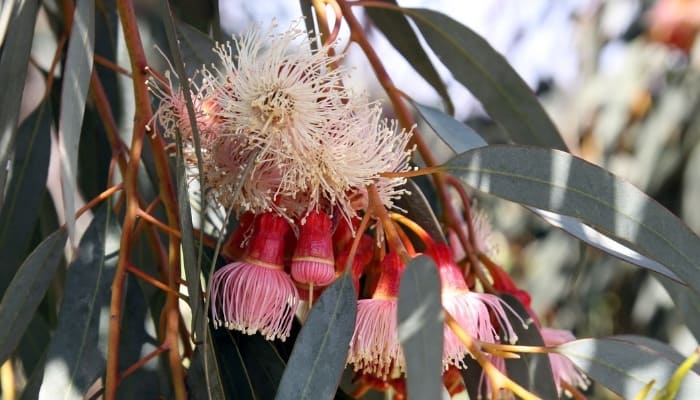
- Botanical name: Eucalyptus torquata
- Average size: 16 feet
- Growth rate: Moderate
- Drought tolerance: Moderate
Originally native to Australian lands, the coral gum prefers growing under strong sunlight where it offers a decent shaded area and acts as an efficient windbreaker.
However, most people choose to grow it for its one-of-a-kind yellowish-pink foliage.
While there isn’t much that you can grow under eucalyptus, the coral gum is ornamental enough on its own.
If you grow something nearby, make sure it has shallow roots to reduce competition over nutrients.
8. Aleppo Pine

- Botanical name: Pinus halepensis
- Average size: 40-50 feet
- Growth rate: Fast
- Drought tolerance: Moderate
Different pines are adapted to Arizona’s climate, and perhaps the most common one of those is the aleppo pine.
It not only offers evergreen shade, but it also has medical benefits in treating skin conditions and relieving common cold symptoms.
The sun isn’t a big deal for aleppo pines, but heat is. Watering 2-3 times every month gets them through the summertime.
If the tree suffers from needle shedding or blight, nitrogen-rich fertilizers can reduce the risk of permanent damage.
9. Desert Fern
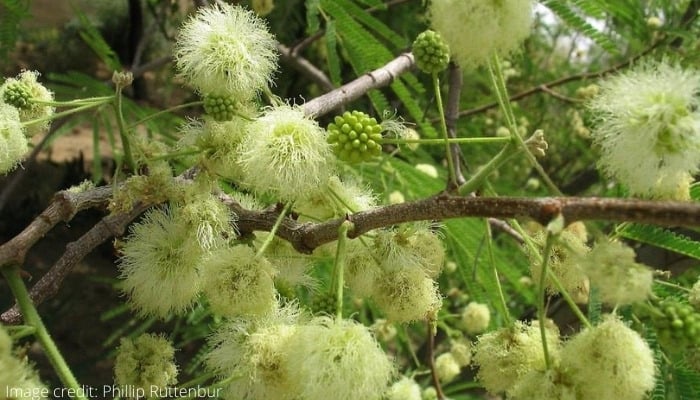
- Botanical name: Lysiloma watsonii
- Average size: 30 feet
- Growth rate: Slow-moderate
- Drought tolerance: High
As the name implies, the native desert fern tree is quite capable of surviving dry conditions.
It’s thornless, produces feather-like cream flowers, and casts wide shade during the summer. However, you might lose the shading effect as it gets colder.
During the winter, the foliage turns into a brownish shade, or it might shed altogether, depending on the temperature.
Like other shedding trees, the desert fern can get a little messy, especially with the seed pods dropping.
10. Coolibah
- Botanical name: Eucalyptus microtheca
- Average size: 35 feet
- Growth rate: Fast
- Drought tolerance: High
Native to Australia, the coolibah handles strong sunlight pretty well, and it’s not very picky when it comes to soil types.
Moreover, this eucalyptus’ drought tolerance increases significantly after the first two or three years of transplanting.
While coolibah is a flowering tree, most people don’t plant it for its blossoms. Its evergreen foliage is what draws people in with the promise of shade all year round.
As a plus, it’s thornless and not very messy. It’s the epitome of low-maintenance landscape trees.
11. Bradford Pear
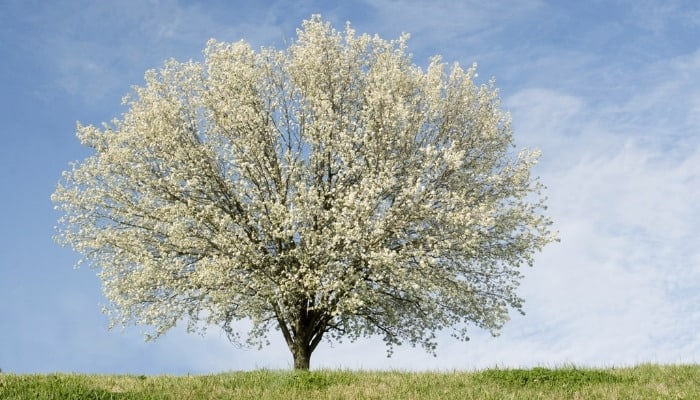
- Botanical name: Pyrus calleryana
- Average size: 50 feet
- Growth rate: Fast
- Drought tolerance: Moderate
The Bradford pear has everything you want from delicate symmetry to white pearly flowers. It’s a shame that it’s quite invasive, and its blossom aroma isn’t very appealing.
Otherwise, it would be the perfect shade tree for yards all over Arizona.
Did you know it’s illegal to sell Pyrus calleryana in South Carolina? It soon will be – all because of its vicious cross-pollination effect.
Keep in mind that its lifespan is only 20-25 years. Additionally, the delicate branches are vulnerable to wind.
12. Cascalote
- Botanical name: Caesalpinia cacalaco
- Average size: 20 feet
- Growth rate: Slow
- Drought tolerance: Moderate
If you’re looking for bushy, evergreen foliage, the cascalote is the way to go. Even during the winter, you still get heavy shade with an added bonus of aromatic lemon-colored flowers.
While Cascalote can survive a moderate drought, its growth might get stunted. Regular watering during the summer typically means a faster growth rate.
To boost growth, you can also try pruning in spring. Just remember to wear gloves because the branches are thorned.
13. Mexican Redbud
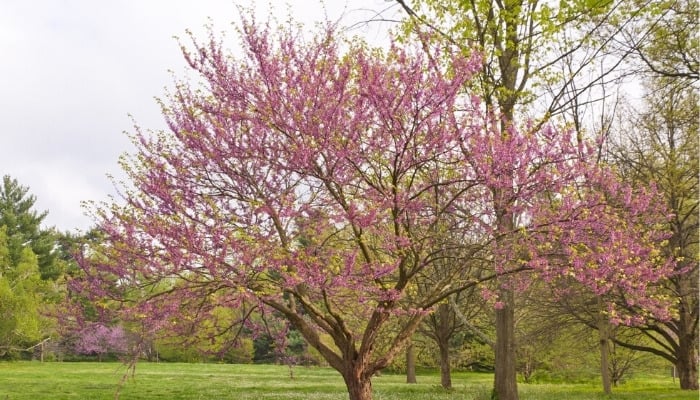
- Botanical name: Cercis canadensis
- Average size: 10-15 feet
- Growth rate: Slow
- Drought tolerance: High
The Mexican redbud offers a nice change from the traditional green foliage with dense pink flowers. So, while you can’t grow cherry blossoms in Arizona, you can settle for this tree instead.
You’ll have to wait for spring to get the full-color boost, though. However, other varieties have white flowers. So, double-check with nurseries before planting the seedlings.
Saponin in the trunk can be slightly toxic, but it isn’t too alarming. In fact, the leaves and flowers are safe to consume.
14. Ironwood
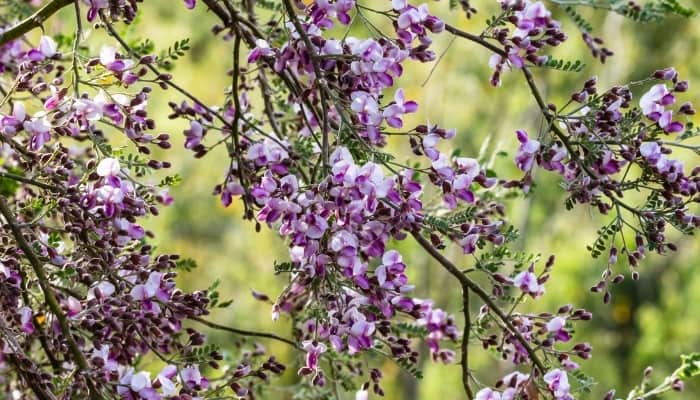
- Botanical name: Olneya tesota
- Average size: 30 feet
- Growth rate: Slow
- Drought tolerance: High
Native to the Sonoran Desert, ironwood trees can handle direct sunlight, heat, and drought.
What makes the ironwood unique-looking is the bluish-gray foliage that lasts all year round. Another characteristic is the extremely dense timber (hence the name.)
Ironwood trees are not exactly endangered, but they’re still protected by law. However, there’s no use cutting down these trees since their timber is quite toxic.
15. Native Mesquite
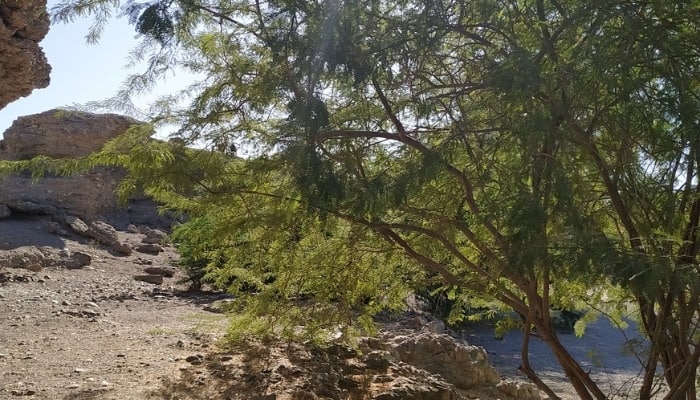
- Botanical name: Prosopis velutina
- Average size: 15 feet
- Growth rate: Moderate
- Drought tolerance: High
Not only is the hardy mesquite capable of surviving a desert-like climate, but it can also take root in rocky soil.
All-in-all, it’s one of the most resilient and low-maintenance shade trees you can grow in Arizona with only messy shedding as a downside.
Thanks to symbiotic bacterial relationships, the mesquite can turn most grounds into fertile lands.
Without human intervention, the branches grow twisted, and the foliage gets bushy. Yet, it doesn’t end up looking disheveled.
Conclusion
Depending on your priorities, the criteria for the best shade trees for Arizona can change.
You can find charming foliage in the coral gums and Mexican redbuds. Or maybe you want to go for evergreen shade trees like the coolibahs and cascalotes.
You can also choose something that goes bare seasonally, like desert willows, if you want more sun exposure during cold winters.
In the end, the decision is yours, but at least now you have some great ideas to get you started.
Image credit: Phillip Ruttenbur

